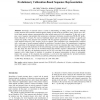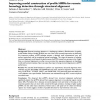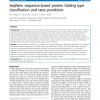67 search results - page 7 / 14 » Predicting and improving the protein sequence alignment qual... |
JCC
2008
13 years 7 months ago
2008
: Knowledge of structural classes is useful in understanding of folding patterns in proteins. Although existing structural class prediction methods applied virtually all state-of-t...
BMCBI
2007
13 years 7 months ago
2007
Background: Remote homology detection is a challenging problem in Bioinformatics. Arguably, profile Hidden Markov Models (pHMMs) are one of the most successful approaches in addre...
BMCBI
2007
13 years 7 months ago
2007
Background: Protein remote homology detection is a central problem in computational biology. Most recent methods train support vector machines to discriminate between related and ...
BMCBI
2005
13 years 7 months ago
2005
Background: The large gap between the number of protein sequences in databases and the number of functionally characterized proteins calls for the development of a fast computatio...
BMCBI
2010
13 years 7 months ago
2010
Background: Protein folding rate is an important property of a protein. Predicting protein folding rate is useful for understanding protein folding process and guiding protein des...



